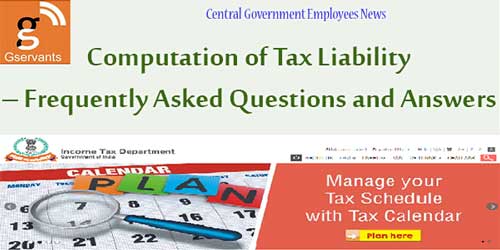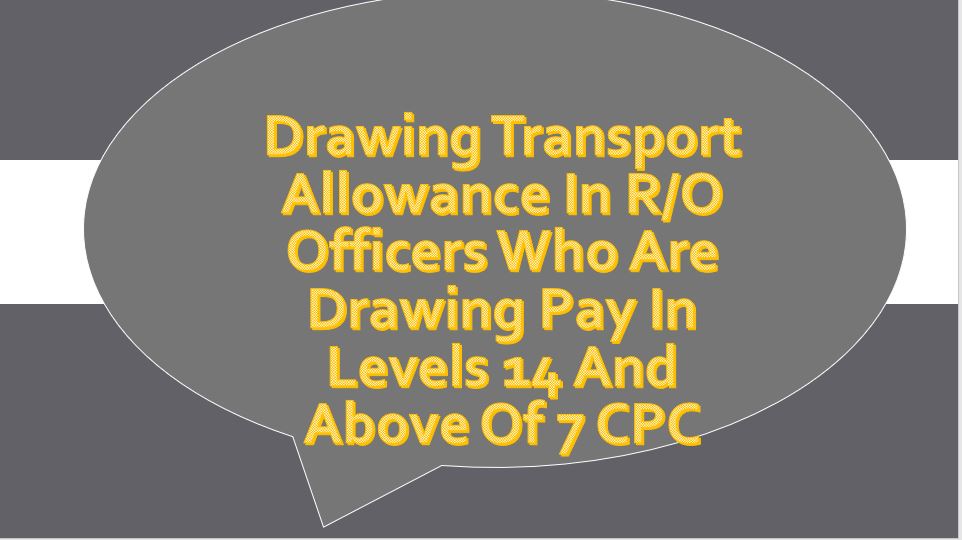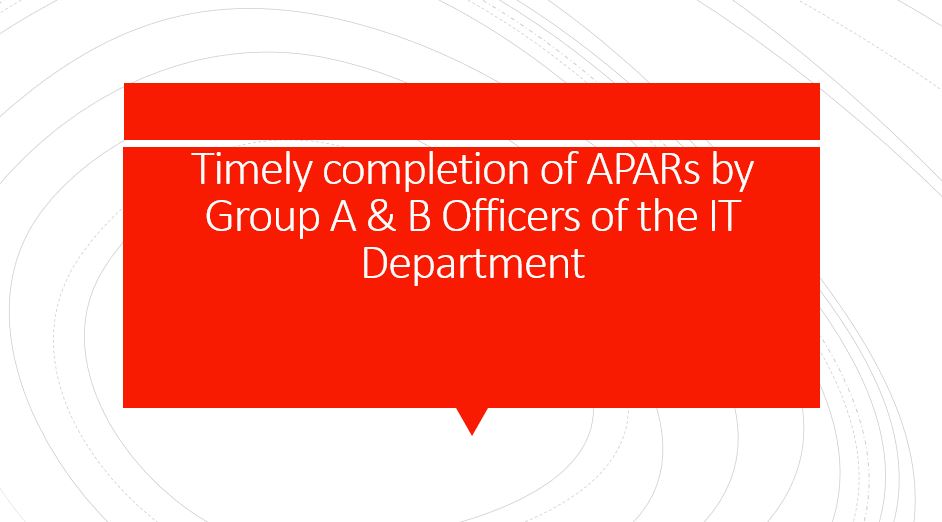Computation of Tax Liability – Frequently Asked Questions and Answers

1. Under how many heads the income of a taxpayer is classified?
Section 14 of the Income-tax Act has classified the income of a taxpayer under five different heads of income, viz.:
• Salaries
• Income from house property
• Profits and gains of business or profession
• Capital gains
• Income from other sources
2. What is gross total income?
Total income of a taxpayer from all the heads of income (as discussed in previous FAQ) is referred to as Gross Total Income.
3. What is the difference between gross total income and total income?
Section 80C to 80U provides certain deductions which can be claimed from Gross Total Income (GTI). After claiming these deductions from GTI, the income remaining is called as Total Income. In other words, GTI less Deductions (under section 80C to 80U) = Total Income (TI). Total income can also be understood as taxable income. Following table gives a better understanding of the difference between GTI and TI :
Computation of gross total income and Taxable Income
| Particulars | Amount |
| Income from salary | XXXXX |
| Income from house property | XXXXX |
| Profits and gains of business or profession | XXXXX |
| Capital gains | XXXXX |
| Income from other sources | XXXXX |
| Gross Total Income | XXXXX |
| Less : Deductions under Chapter VI-A (i.e. under section 80C to 80U) | (XXXXX) |
| Total Income (i.e., taxable income) | XXXXX |
Note : Inter source losses, inter head losses, brought forward losses, unabsorbed depreciation, etc., (if any) will have to be adjusted (as per the Income-tax Law) while computing the gross total income.
4. How to round off total income before computing tax liability?
As per section 288 A, total income computed in accordance with the provisions of the Income-tax Law, shall be rounded off to the nearest multiple of ten. Following points should be kept in mind while rounding off the total income:
First any part of rupee consisting of any paisa should be ignored.
After ignoring paisa, if such amount is not in multiples of ten, and last figure in that amount is five or more, the amount shall be increased to the next higher amount which is in multiple of ten and if the last figure is less than five, the amount shall be reduced to the next lower amount which is in multiple of ten and the amount so rounded off shall be deemed to be the total income of the taxpayer.
Illustration for better understanding
If the taxable income of Mr. Keshav is Rs. 2,52,844.99, then first paisa shall be ignored, i.e., 0.99 paisa shall be ignored) and the remaining amount of Rs. 2,52,844 shall be rounded off to Rs. 2,52,840 (since last figure is less than five). If the total income is Rs. 2,52,845 or Rs. 2,52,846.01, then it shall be rounded off to Rs. 2,52,850 (since the last figure is five or above).
5. Can I claim deduction for my personal and household expenditure while calculating my taxable income or profit?
No, you cannot claim deduction of personal expenses while computing the taxable income.
While computing income under various heads, deduction can be claimed only for those expenses which are provided under the Income-tax Act.
6.Most of my income is given away in charity and I am left with just enough money to meet my personal requirements. What will be considered as my income?
What is done after the income is earned by you will not give you tax exemption. However, contribution to approved institutions will give you the benefit of deduction from taxable income under section 80G subject to limits specified therein.
7.My daughter stays in USA. She owns a house in India and has let it out. She has asked tenants to pay rent to me. She has not received any rent. Is she still liable to tax? What if she transfers the house to me?
Rental income is charged to tax in the hands of the owner of the property. Your daughter is the owner of the house and, therefore, she is liable to pay tax, even though you receive rent. If the house is transferred to you, then you will become the owner and you will have to pay Income-tax on the rental income.
8. Is there any limit of income below which I need not pay tax?
At this moment (i.e., for the financial year 2014-15) Individual, HUF, AOP, and BOI having income below Rs. 2,50,000 need not pay any Income-tax. In respect of resident individuals of the age of 60 years and above but below 80 years, the basic exemption limit is Rs. 3,00,000 and in respect of resident individuals of 80 years and above, the limit is Rs. 5,00,000. For other categories of persons such as co-operative societies, firms, companies and local authorities, no basic exemption limit exists and, hence, they have to pay taxes on their entire income chargeable to tax.
9. How to compute the total tax liability?
After ascertaining the total income, i.e., income liable to tax, the next step is to compute the tax liability for the year. Tax liability is to be computed by applying the rates prescribed in this regard. For rates of tax, refer “Tax Rate” section. Following table will help in understanding the manner of computation of the total tax liability of the taxpayer.
Computation of total income and tax liability for the year
| Particulars | Amount |
| Income from salary | XXXXX |
| Income from house property | XXXXX |
| Profits and gains of business or profession | XXXXX |
| Capital gains | XXXXX |
| Income from other sources | XXXXX |
| Gross Total Income | XXXXX |
| Less : Deductions under Chapter VI-A (i.e., under section 80C to 80U)) | (XXXXX) |
| Total Income (i.e., taxable income) | XXXXX |
| Tax on total income to be computed at the applicable rates (for rates of tax, refer “Tax Rate” section) | XXXXX |
| Less : Rebate under section 87A (discussed in later FAQ) | (XXXXX) |
| Tax Liability After Rebate | XXXXX |
| Add: Surcharge (discussed in later FAQ) | XXXXX |
| Tax Liability After Surcharge | XXXXX |
| Add: Education cess @ 2% on tax liability after surcharge | XXXXX |
| Add: Secondary and higher education cess @ 1% on tax liability after surcharge | XXXXX |
| Tax liability before rebate under sections 86, section 89, sections 90, 90A and 91 (if any) (*) | XXXXX |
| Less : Rebate under sections 86, section 89, sections 90, 90A and 91(if any) (*) | (XXXXX) |
| Tax liability for the year before pre-paid taxes | XXXXX |
| Less: Prepaid taxes in the form of TDS, TCS and advance tax | (XXXXX) |
| Tax payable/Refundable | XXXXX |
(*) Rebate under section 86 is available to a member of association of persons (AOP) or body of individuals (BOI) in respect of income received by such member from the AOP/BOI.
Rebate (i.e., relief) under section 89 is available to a salaried employee in respect of sum received towards arrears of salary, gratuity, etc.
Rebate under sections 90, 90A and 91 is available to a taxpayer in respect of double taxed income, i.e., income which is taxed in India as well as abroad.
Note : For provisions relating to Minimum Alternate Tax (MAT) in case of corporate taxpayers and Alternate Minimum Tax (AMT) in case of non-corporate taxpayers refer tutorial on “MAT/AMT”.
10. How to round off the tax liability?
As per section 288B, tax payable by the taxpayer or tax refundable to the taxpayer shall be rounded off to the nearest multiple of ten, following points should be kept in mind while rounding off the tax :
First any part of rupee consisting of any paisa should be ignored.
After ignoring paisa, if such amount is not a multiples of ten, and the last figure in that amount is five or more, the amount shall be increased to the next higher amount which is a multiple of ten and if the last figure is less than five, the amount shall be reduced to the next lower amount which is a multiple of ten; and the amount so rounded off shall be deemed to be the tax payable by the taxpayer or refundable to the taxpayer.
Illustration for better understanding
If the tax liability or refund due to Mr. Keshav is Rs. 2,52,844.99, then first paisa shall be ignored, (i.e., 0.99 paisa shall be ignored) and the remaining amount of Rs. 2,52,844 shall be rounded off to Rs. 2,52,840 (since last figure is less than five). If the tax liability or refund due is Rs. 2,52,845 or Rs. 2,52,846.01, then it shall be rounded off to Rs. 2,52,850 (since the last figure is five or above).
11. What is rebate under section 87A and who can claim it?
An individual who is resident in India and whose total income does not exceed Rs. 5,00,000 is entitled to claim rebate under section 87A. Rebate under section 87A is available in the form of deduction from the tax liability. Rebate under section 87A will be lower of 100% of income-tax liability or Rs. 2,000. In other words, if the tax liability exceeds Rs. 2,000, rebate will be available to the extent of Rs. 2,000 only and no rebate will be available if the total income (i.e. taxable income) exceeds Rs. 5,00,000.
Illustration for better understanding
Mr. Raja (age 35 and resident in India) is a salaried employee. His taxable salary for the year 2014-15 amounted to Rs. 5,84,000. He has deposited Rs. 94,000 in public provident fund untitled for deduction under section 80C. The employer has deducted tax of Rs. 22,660 from his salary. What will be his tax liability for the year?
| Particulars | Amount |
| Income from salary | 5,84,000 |
| Income from house property | Nil |
| Profits and gains of business or profession | Nil |
| Capital gains | Nil |
| Income from other sources | Nil |
| Gross Total Income | 5,84,000 |
| Less : Deductions under section 80C on account of investment in PPF | 94,000 |
| Total Income (i.e., taxable income) | 4,90,000 |
| Tax on taxable income to be computed by applying the applicable rates (*) | 24,000 |
| Less : Rebate under section 87A (**) | 2,000 |
| Tax Liability After Rebate | 22,000 |
| Add: Surcharge ($) | Nil |
| Tax Liability After Surcharge | 22,000 |
| Add: Education cess @ 2% on tax liability after surcharge | 440 |
| Add: Secondary and higher education cess @ 1% on tax liability after surcharge | 220 |
| Tax liability before rebate under sections 86, section 89, sections 90, 90A and 91 (if any) | 22,660 |
| Less : Rebate under sections 86, section 89, sections 90, 90A and 91 (if any) | Nil |
| Tax Liability for the Year Before Pre-paid Taxes | 22,660 |
| Less: Prepaid taxes in the form of TDS | 22,660 |
| Tax payable/Refundable | Nil |
(*) The tax rates for the financial year 2014-15 applicable to an individual below the age of 60 years are as follows :
Nil upto income of Rs. 2,50,000
10% for income above Rs. 2,50,000 but upto Rs. 5,00,000
20% for income above Rs. 5,00,000 but upto Rs. 10,00,000
30% for income above Rs. 10,00,000.
Apart from above, education cess @ 2% and secondary and higher education cess @ 1% will be levied on the amount of income-tax. Applying the above normal tax rates, tax on income (before cess) will come to Rs. 24,000.
(**) Rebate under section 87A will be Rs. 2,000, being lower of following :
(a) Tax on total income, i.e., Rs. 24,000; or
(b) Rs. 2,000
($) Surcharge is levied @ 10% on the amount of income-tax where the total income of the taxpayer exceeds Rs. 1 crore. In this case, the total income is below Rs. 1 crore and, hence, no surcharge will be levied.
Illustration for better understanding
Mr. Kapoor (age 35 years and resident in India) is running a medical store. Taxable business income for the year amounted to Rs. 5,84,000. He does not have any other income. He deposited Rs. 50,000 in public provident fund. Can he claim rebate under section 87A?
Rebate under section 87A is available to an individual who is resident in India and whose total income does not exceed Rs. 5,00,000. In this case, the gross total income of Mr. Kapoor is Rs. 5,84,000 and he has deposited Rs. 50,000 in PPF and, hence, total income i.e. taxable income will come to Rs. 5,34,000 (Rs. 5,84,000 less Rs. 50,000). Rebate under section 87A is available only if the total income does not exceed Rs. 5,00,000. In this case, the total income exceeds Rs. 5,00,000 and, hence, he cannot claim rebate under section 87A.
source: incometaxindia.gov.in
Get Free Email Updates
Follow us on Telegram Channel, Twitter & Facebook and Whatsapp Channel for all Latest News and Updates




An employed granted home loan from a bank and paying Rs.3,00,000.00 p.a.on account of interest. Income of his/her spouse(who is also govt. employee) considered in sanctioning process of home loan. Kindly clarify whether rebate in income tax against interest paid on home loan is admissible only to employee who granted home loan or his/her spouse also entitled for same rebate at any percentage fixed by ownself.